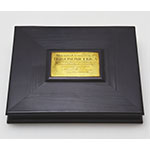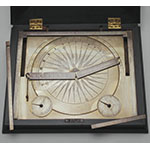Device for determining the value of a trigonometric function (sine and cosine) of a known angle or, vice versa, for finding the value of an angle when its function is known. The machine was invented by Sir Samuel Morland in 1663 and built by John Marke. The instrument consists of a rectangular box holding a disk with a toothed circumference. At the center of the disk are mounted compasses with a fixed arm and a mobile arm rotating with the disk itself. Below are two smaller disks. The left-hand one shows the angle values. Its index is connected to the toothed circumference of the large disk and completes one revolution for every 30° traveled by the mobile compass arm. The right-hand disk shows the linear sine values. Its index is connected to the mobile horizontal rod on the upper half of the box, and completes one revolution for every 25 units traveled by the rod on the side channels. The numbering of the horizontal rod and vertical channels basically represents the sine grid or reduction quadrant. The instrument is housed in an ebony case with a lid and engraved plate. Provenance: Medici collections.










